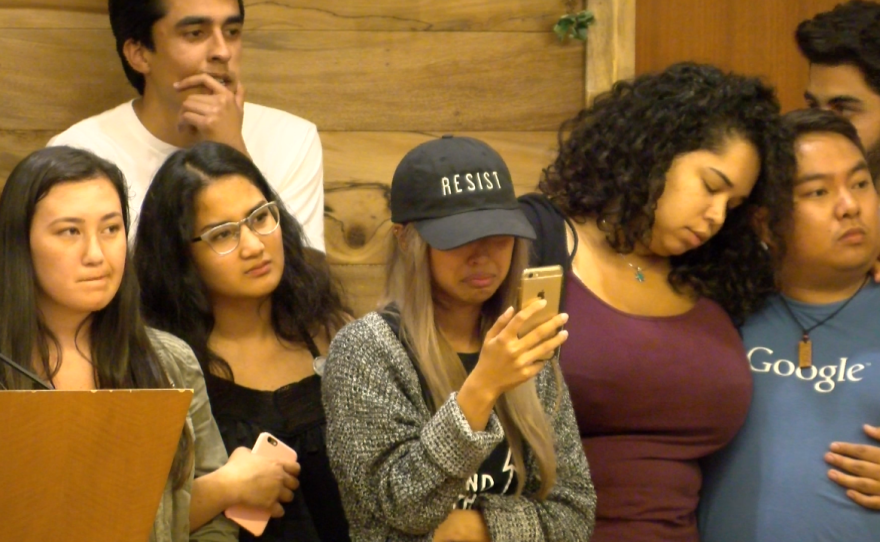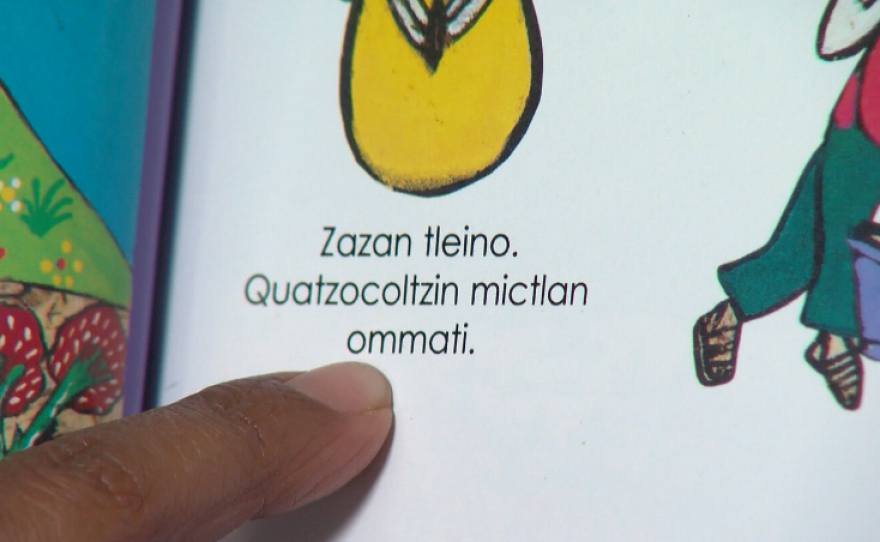San Diego State will soon offer course on the language of the Aztecs. Meghan Burk said the announcement comes a month after an advisory group to the university's president voted to discontinue use of the mascot.The vote was nonbinding but continues the decade-long debate on campus about the appropriateness of using people to promote the school and their sports teams. The director of the center says the courses in response to that.This is the reaction to respect and reaction to doing things right.As with any language, it will give students insight into a unique worldview.Zazan tleino. Quatzocoltzin mictlan ommati . In English this is saying up and down the well. I'm -- so it is referencing the underworld that this part of the world vision before colonialism and the influence of the Catholic religion. It's a place of rest.The classes be live stream from University of Zacatecas .Velma Vicki Calvario , graduate student assistant, Nahuatl class at SDSU is now here in the studio with us. She's going to be helping the class. Thank you for coming in. So tell us how did you learn the language?Before that a term that you use right now was the language. Let me point out that we are working on the revitalization efforts because the language is alive.Thank you for clarifying. Tell us about how you learned it.I am the first child for both my parents who are from a Nahuatl community. My father migrated over to San Diego. I was born here however my mother was not used to the lifestyle out here and urine to go back home. Prior to beginning elementary school it was a lot more feasible for my mother and I to travel back home and spend long periods of time. Me wanting to play with other children I think that was a big incentive for me to learn the language more than what was spoken to me at home because it really does I really want to play with the children.So you grew up in Logan Heights and you felt like people around you did not understand that. Tell us about that feeling.It was pointed out to me that I was an outsider. But being a young child I did not understand what was pointed out to me was I had darker skin and my features were not like the rest of my peers. I grew up believing that they shared this thing that I knew.But you felt like they did not so -- not know some of the Mexico that you knew.We start sharing her experiences so it was very common for the children to go back to Mexico for Christmas break or summer break. Of course, your little kid and did a lot of things with your cousins and played new games and that is what I wanted to come back and brag to my peers that my vacation was better than yours. So I recall a specific time being with my friends and listening to their conversations with regards to what they have done in Mexico and describe the place. I heard of buildings and cars and lots of Spanish and I remember there was a change in my feeling and wanting to brag about it and then kind of been taken back by all this information in thinking that does not sound like the Mexico that I was in. Thinking actually that my parents had lied to me that they had not taken me to Mexico but it did not sound like the Mexico that I always visited and I called home.So if are focusing on how language can really bring with it a whole culture, what are some of the values in the Nahuatl language are different from mainstream options that we have here?Lots of close knit family and ties with agriculture specifically my community where agriculture is very much important. I think that's a reason I was able to grow up at a young age in the community because of my mother's attachment to her community, family and Latin so because of her strength and love for who she is and her community and her culture and her language is that I've been able to not lose it because even though I learned as a child and coming back to the United States, it made it harder for me to be able to go back to the community for longer periods of time.Are there other people here in San Diego you said that the language is still alive in some parts. Have you met other people who speak it?Yes, I have. Nahuatl is the largest languages spoken in the Mexico. However, it may not seem so because it's very separated by locations and regions so there's the area in central Mexico and people in southern Mexico.This class is the beginning of an effort to really look more reviving this culture here in San Diego. What what else does they promise in the coming years?What's really exciting is a program that's going to be established is next semester with the first semester of a two-year program into this language. So it's me taking 15 students to take part in this case is going to be working on getting students to really learn the language which is more feasible with the smaller class then we have students in the classroom.Are there other aspects of the culture that might come up like music?Of course. The way the class is going to be taught it's going to be by a community speaker who was part of the organization who has for many years worked on efforts to revitalize the language by working with committee members and teaching them about their language in various aspects such as the history but also the aspects of it so they can be empowered and work on revitalizing the language and their community.Thank you so much for coming and helping us get a handle on the culture that is still very much alive in Mexico and still has roots for many people here in San Diego.Yes, it has roots for many people but also very alive among many individuals here in the U.S.She will be helping students at Senegal state learned and Nahuatl language .
San Diego State is reviving a course on the indigenous Aztec language, Nahuatl, next semester. The announcement comes as faculty and students revive a decade-long debate on campus about the appropriation of the Aztecs as a mascot.
“This is a reaction to respect, to notions of respect,” said Center for Latin American Studies Director Ramona Pérez. “It’s a reaction to doing things right.”
She said the university had offered a course on the language in the early 2000s, when concerns about the appropriateness of using a people to promote schools and their sports teams first flared up. The university retired the mascot’s more stylized costumes and strove for historical accuracy, adopting an educational ambassador and the Nahuatl class.
But the class faded away, along with the federal grant that funded it.
“It’s supported by the administration this time. Hopefully it’s not going to go away,” Pérez said. “It’s going to be a natural part of student life here on campus.”
RELATED: Does San Diego State’s Aztec Mascot Perpetuate Racism?
For Vicki Calvario, who grew up speaking English at home in Logan Heights and Nahuatl during summers with her grandmother in Guerrero, Mexico, the importance of the course transcends campus politics.
She said indigenous cultures and languages have long been overshadowed by the mainstream, including in the predominantly Latino Logan Heights neighborhood.
“I was never thought of as being Mexican. It was always pointed out to me that I did not fit into that community because my skin color was very much darker than the rest of my Mexican peers,” Calvario said. “My Mexico and my Mexico reality was different than what they noted as Mexico.”
Calvario is now earning a master’s degree in anthropology and studying efforts to revive the Nahuatl language in Guerrero. She said learning a language offers important insight into the culture of those who speak it.
“It’s very motivating and encouraging to know that now more individuals are going to be becoming aware of the beauty and the splendor of this language that is not dead. It’s very much alive,” she said. “And hopefully this will be an entry into them learning about the other worlds that are in Mexico.”
Calvario offered an example of the kind of context language can provide — and of how Spanish colonialism has challenged preservation of Nahuatl. She read the following phrase from a book.
“Zazan tleino. Quatzocoltzin mictlan ommati.”
“In English this is saying, ‘Up and down the well I got used to hell,’” Calvario said. “So mictlan is referencing the underworld that is part of the Nahuatl world vision before colonialism and the influence of the Catholic religion. Mictlan was just a place where people went after one ceased to be in the physical world. It was not a hell, it was just a place of rest.”
Calvario will assist students in the course, which is being livestreamed from the University of Zacatecas. The class is open to any student and members of the public through Open University, but will be capped at 15 students. The university will add sections in subsequent semesters as it builds a full, two-year program in the language.
The University of Utah, Stanford and UCLA also offer the course in this format.
“It’s an amazing language. It’s an amazing worldview. And I think once people get into it, they’re going to find that what they learn not only in terms of language, but understanding a new way to be in the world is really exciting,” Pérez said.
There is no estimate for the number of Nahuatl speakers in the United States, but Pérez said there is a need for Nahuatl interpreters across social service sectors. She added many of Mexico’s classical texts are in Nahuatl.

As for the Aztec mascot, its long-term future is unclear. In a non-binding action, the University Senate voted to discontinue the mascot last month, just seven months after a divided Associated Students voted in favor of the mascot. Both decisions are meant to advise the university’s president, and in the midst of a search for her replacement, interim President Sally Roush is unlikely to make the call.







